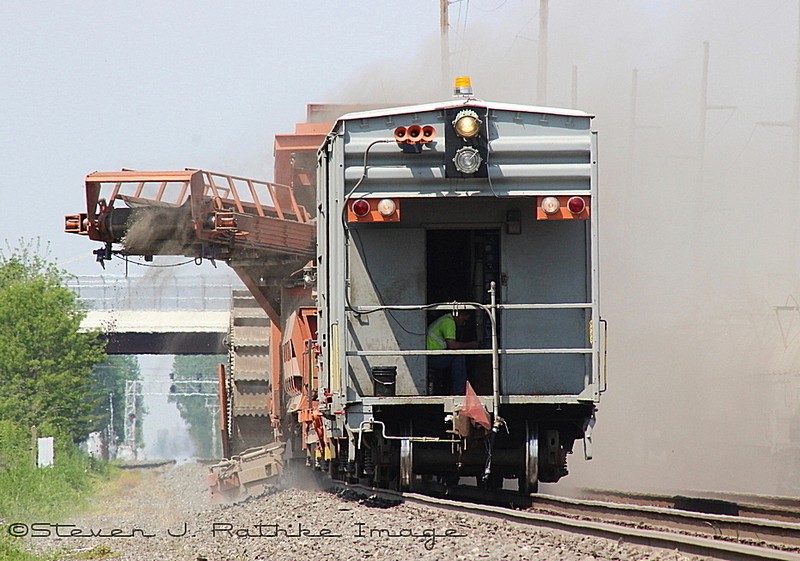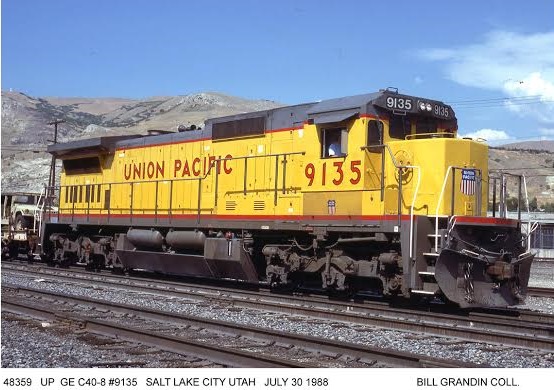
|
A very large part of my rail fanning life was spent in a time prior to cell phones and the internet. I fondly recall many days of going track side hoping to see exotic diesel consists, detour trains, and maybe even some foreign power. It was the anticipation of what the day would bring that was most thrilling to me. I really enjoyed that aspect of our hobby! Don't misunderstand me, I love my cell phone and the role it plays regarding train watching. I recall several train watching trips that I made back in the day where I never saw a train. I was "skunked" due to track work. With today's technology, that would never happen. Just a few clicks of the mouse or some phone calls would have provided me with enough information to make my journey at another time.
While track side this summer, you are very likely to see some work trains on the mainlines. These can vary a little among the railroads, but most of them play the same role. Ballast trains and rail trains are the most common and may be seen bringing in fresh supplies for the gangs to work with. Tie trains can also be seen dropping product as well. In addition to these trains, you may also see another type of track maintenance train referred to as a "ballast cleaner." When you think of railroad track and what must be done to properly maintain it, most of us immediately focus on the rails, ties and spikes, and maybe fresh ballast. But a ballast cleaner? Why would a railroad want to wash rock? Ballast is the foundation of the track substructure. It plays a very important role in allowing the rails and ties to uniformly distribute the weight of passing trains. For this to occur, the ballast has to be flexible. Over time, the rock which comprises the ballast bed loses it edges and becomes round. Once this happens, drainage becomes a problem as the pieces of the broken rock edges can bind with other particles. When it is mixed with water that cannot properly drain, the ballast bed can begin to resemble concrete. Without the ability to flex underneath passing trains, the rails and ties can irregularly settle and begin to affect track geometry. An example of this is depicted in the first picture. As you can see, the lower rail has a drainage issue and has developed a mud spot. If left untouched, the bottom rail will continue to sink creating lateral motion for all equipment passing over the track.
Recently, I was making the return run home on the local when the dispatcher instructed us to take the siding. His double track mainline was now single tracked due to the ballast cleaner working on track two. With three hot eastbound intermodals approaching and two westbounds waiting at the next control point, we were put in the hole for traffic to clear. In my years on the railroad, I have passed many ballast cleaners but have never seen one at work. It is amazing to watch what these machines can do. With rocks flying and a dust cloud following, I observed it from a safe distance as it slowly advanced down the track. It is also extremely loud.
Following the ballast cleaner are two machines: the Mark 4 and the Regulator. They both perform different follow up functions behind the cleaner. The Mark 4's main job is to align and straighten rails so that they are cross level. In the final photo, the Mark 4 is the machine on the far right side flying the American flag and the Regulator is on the left. The last machine is called a Regulator. It pulls rock up into the rail gauge and fills in the cribs, which are areas between the ties. It also helps create the shoulder of the ballast on the field side of the tracks as well as the gauge side. Before leaving a section of track, the Regulator brooms off the ties leaving a very finished look.
So the next time you are out train watching and you get "skunked" due to track work, think about the importance of track maintenance. Without the the men and women working on the gangs, eventually the trains wouldn't run!
|
News And Photos From Our American CRO Contributors.
At Chester, South Carolina on May 31st, 2016, Ed Sharpe photographed LANCASTER & CHESTER RAILROAD EMD-built SD40T-2 LC 6002 (former Southern Pacific 8257), and former Union Pacific C40-8 9146 was rebuilt to a C40-8S Road Slug numbered LC 9146. These three photographs were taken next to the Norfolk Southern main line (which is the far track shown in the photos), where NS rail traffic is interchanged with the Lancaster & Chester RR.


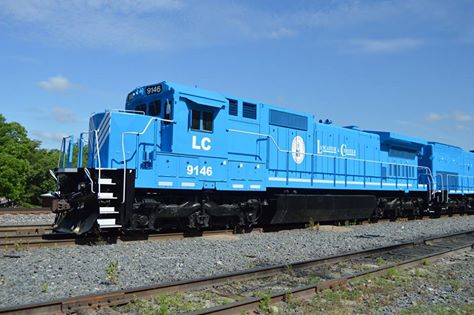
On June 10th Mike Garza shot Nickel Plate Road #765 on its way Franklin Park Illinois for display. It had a 19 car train. The train was on Metra trackage at Oak Lawn, Illinois. NKP 765 is a 2-8-4 Berkshire type steam locomotive built for the Nickel Plate Road in 1944 by the Lima Locomotive Works. In Lima, Ohio it would be classified as an "S-2" class Berkshire, the locomotive operated fast, heavy freight and passenger trains until retirement in 1958. Pere Marquette 1225 is also a Lima built Berkshire very similar in appearance and specifications to 765. Following a restoration in 1979 and after a major overhaul in 2005, 765 operates in public exhibition and passenger excursion train service. It is owned and maintained by the Fort Wayne Railroad Historical Society.

Mike Garza also bagged South Shore 2006, which had just arrived at NRE for repairs in Dixmoor, IL on May 24th.

Jim Pearson provided the following great shots: On May 10, 2016 - Paducah and Louisville Railway U of L engine 2013 leads a loaded coal train from Dotki Mine as it approaches the old Yard Limit sign at Providence, KY on CSX's Morganfield Branch. - Tech Info: 1/640 | f/14 | ISO 1250 | Lens: Sigma 150-600 @ 270mm on a Nikon D800 shot and processed in RAW.

May 30, 2016 - CSX Q587 (Evansville, IN - Nashville, TN) heads south out of Nortonville, KU with what looks to be a brand new rebuilt GATX/GMTX switcher #163 in the lashup of six engines as they made their way down the Henderson Subdivision. - Tech Info: 1/640 | f/7.6 | ISO 140 | Lens: Nikon Sigma 150-600 @ 300mm on a Nikon D800 shot and processed in RAW.
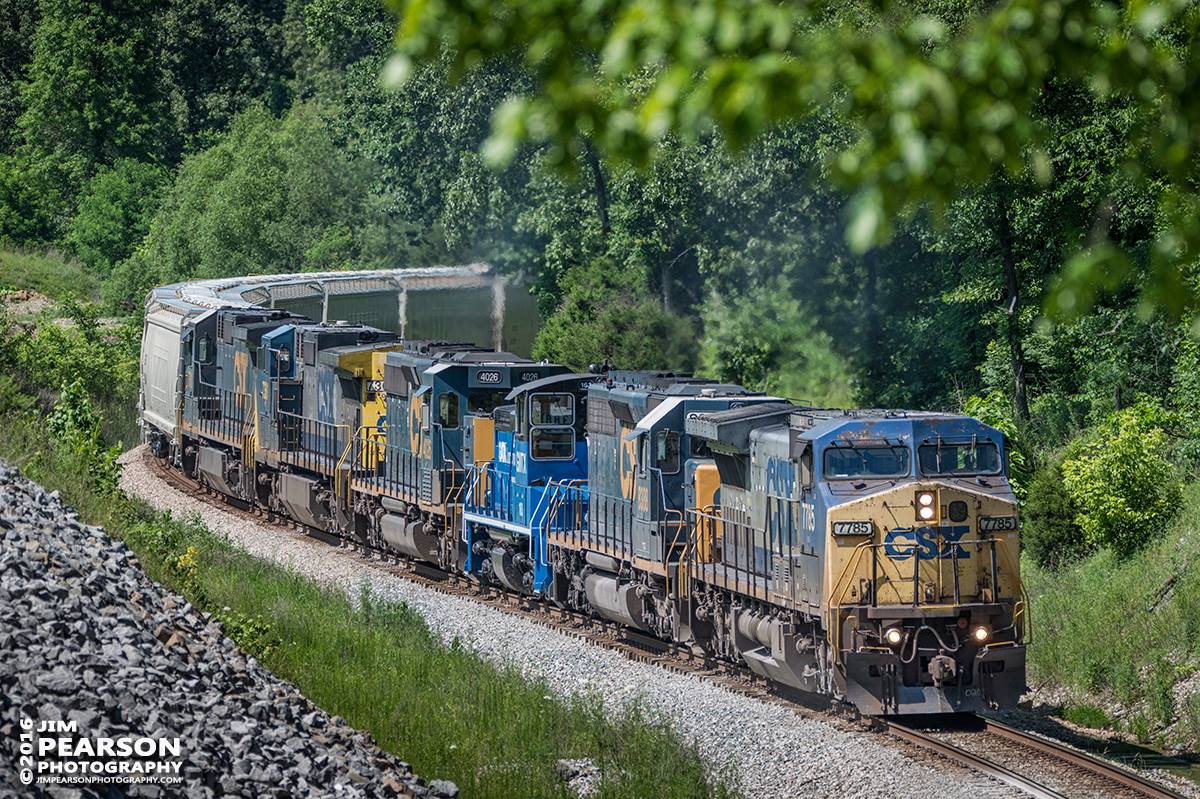
May 11, 2016 - CSX Q597 makes its way up the grade at Morton's Junction in Mortons Gap, KY as it heads south on the Henderson Subdivision. - Tech Info: 1/2000 | f/6 | ISO 720 | Lens: Sigma 150-600 @ 440mm on a Nikon D800 shot and processed in RAW.

April 27, 2016 - CSX Z462-27 (Paducah & Louisville Railway WW1, Louisville Gas & Electric) loaded coal train heads east on CSX's Morganfield Branch as it prepares to pass the PeeVee Spur at Madisonville, KYy with PAL UK engines 4522 and 2012 along with UofL 2013 as power. - Tech Info: 1/1250 | f/5.6 | ISO 640 | Lens: Sigma 150-600 @ 320mm on a Nikon D800 shot and processed in RAW.

Believe it or not this is May 14th, 2016 in Spencer, North Carolina! In May the newly restored Southern Railway Big John rolled out of Spencer yard behind preserved Southern Railway 3170 and 2601.

B-Train David Lemke was fortunate to catch a pair of former GO TRANSIT F59PH's (97-99) in their new METRA garb. Finally the sun came out for the F59's to be shot, soon after a freight blocking this track view had passed.

The morning of June 2nd was hot, in fact Too Hot George Manley called it a day at 12:00 noon after railfaning at Stockton all morning, He didn't see any WB's all morning, but as it turns out, UP had a derailment on the Tehachapi that saw 10 cars or so go on the ground. A visit to the Sierra Northern in Oakdale saw SERA 131 (GP9) and SERA 50(GP20) in front of the engine house and (GP 20) SERA 48 in gold coupled to the dinner train, but nothing going on...Where Hersey's used to be, there are now a large number of covered hoppers, couldn't tell if they were stored or in service.
This photo shows BNSFEB, the Z-9 with 8205 leading a five unit team is passing thru the signals near the end of the siding at East Escalon...Running slow, BNSF traffic faces a pile of 40 MPH slow orders as maintenance is in full swing.

Here is a mug shot of C-4 8205 on the EB Z-9

A shot of the Sierra Northern dinner train with EMD GP20 SERA 48 in gold paint, tied down at their depot for week end operations.


A mug shot of BNSF GP60 199 who was recently painted in H-4 paint and recently tagged by graffiti vandals, is coupled to BNSF SD40-2 1705 and will take a drag to Stockton shortly and is pumping up the air at Riverban, CA On this day Riverbank Yard was empty, with only 12 road units on hand, most of them from the SB trains arriving from Oregon and Washington.

On June 9th, Richard W. Elleby shot the Cargill Switch Job as it rounds the curve from the Cargill plant here in Hammond, Indiana to deliver interchange to Norfolk Southern at Colehour Yard and for Lever's Huge Hammond Soap Plant. Was finally a treat to get a shot of this Switch Job.

IHB 1506 and IHB 1508 were shot by Tom Boylan on June 6th, at Willard, Ohio while in transit to New York State. The pair arrived at American Motive Power loco shop in Dansville, NY June 9th, where they will be retro-fitted with new Caterpillar compressed natural gas engines. These will be the first two to be done. Afterwards, they will be tested in revenue service with pairs of other IHB switcher sent to AMP later.
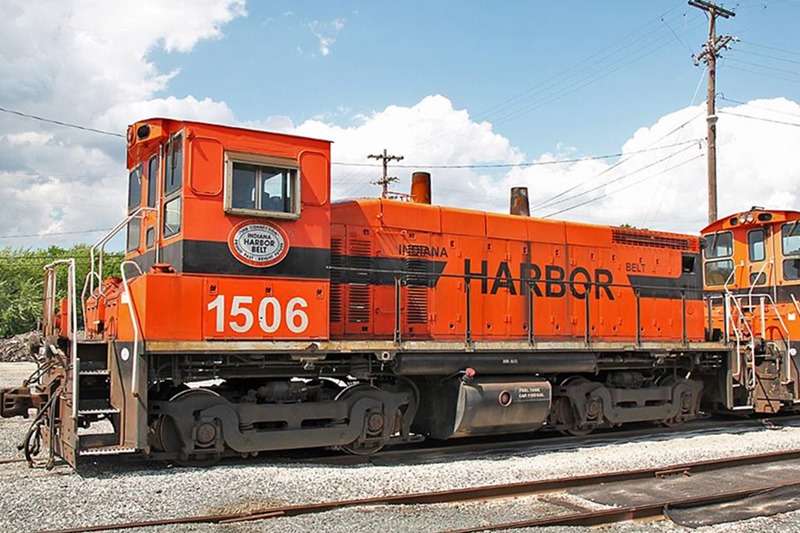
At Franklin Park, IL on June 11th, 2016 Jason Murray shot NRE-Built 3GS21B genset IHB 2141

|
Mike Ray Shot NS SW1500 2622 at Chattanooga, TN in October 2014 |
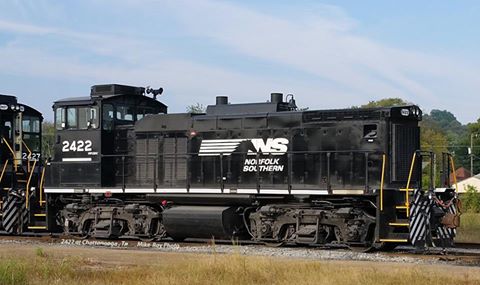 |
Walter Pfefferle CRO Web Guy
Time for another road trip so decided to head to Erie PA to see what was happening along the CSX NS lines between Buffalo and Erie.
Monday June 13th
First up was the local switcher at Hamburg NY. CSX GP40-3 6501 idling in the CSX yard.
Next was a stop at Ripley NY near the NY PA border where NS has a passing siding. No NS trains but did catch some CP that seemed to follow me. CP 9710 with CP 8719 and CP 6242 rolled through with a long intermodal train.
Not long after a eastbound intermodal with CP 9714 and CP 9775 rolled through.
In between the two CP led trains CSX SD40-2 4078 bring CSX ES40DC 5244 and CSX SD50 west through Ripley with an empty oil train.
I then headed to Erie PA and the GE plant to see if anything was waiting to be lifted. Luck was with me and FERROMEX 4807 and 4806 were sitting on the ready track.
Looking the other way Connecticut DOT 231 GE P32AC-DM was looking forgotten and I figured was in for repairs and a new paint job.
Tuesday June 14th
Beautiful sunny day so was trackside by 7 AM in Erie at Liberty Street crossing. Soon things started happening with about 10 trains in 90 minutes.
A CSX westbound showed up with BNSF 6417 BNSF 4274 BNSF 6663 CSX 89 and CSX 8019. They were coming out of the low morning sun so caught this going away shot.
Next up came the AMTRAK Lakeshore Limited with AMTRAK 24 and 11 cars
It was then off to the GE plant and caught CEFX 2022 BNSF 6970 and CEFX 2042 on the test track.
After checking out GE I then headed east and caught CEFX 1014 and CP 8636 with an eastbound in North East PA.
A few more trains there then headed to Bort Road just outside North east PA. A favourite spot for railfans. Not to be disappointed a westbound CSX rolled through with CN 2287 CN 2608 BNSF 7841 and UP 5934 with a long intermodal.

Another Canadian visitor as CP 8812 and CP 9815 lead a westbound intermodal past Bort Rd.

Finally caught NS 7594 roaring out of the sun and heading east as it took the long sweeping curve.
Wednesday June 15th
Back to the Franklin Street bridge in Erie and caught AMTRAK lakeshore Limited with AMTRAK 133 leading. This was New York Central 4 track mainline years ago.

Back to GE and now there were 4 FERROMEX units waiting to be lifted and delivered.

East Erie Commercial Railway looks after all the track in the Erie plant as well as the test track. Hard to get a shot of it but here we see a NS and BNSF unit parked in front of it.

Off to Bort Road North East PA and caught two new rebuilds CSX SD40-3's 4233 and 4390. Nice looking units.


Bort Road just east of North east PA saw more action as CN 260 and CN 2287 were now heading east after passing through here the day before.
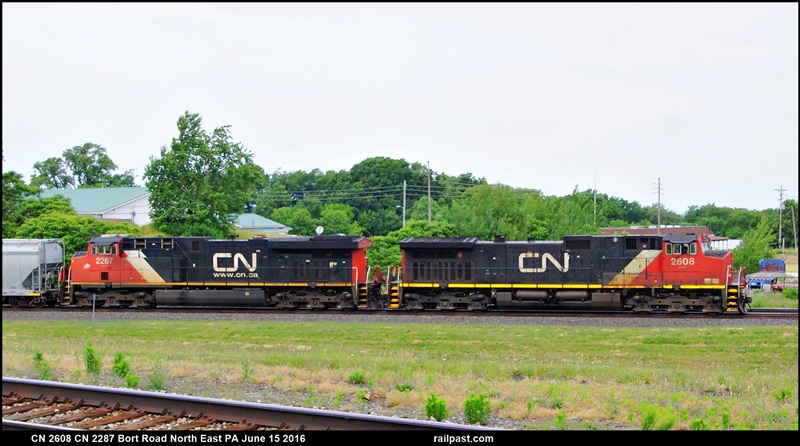
CP 8726 and CEFX 1035 were not far behind as they rolled east.

Caught NS 9085 and NS 946 at Bort Road as they take the long sweeping curve before passing under I 90.
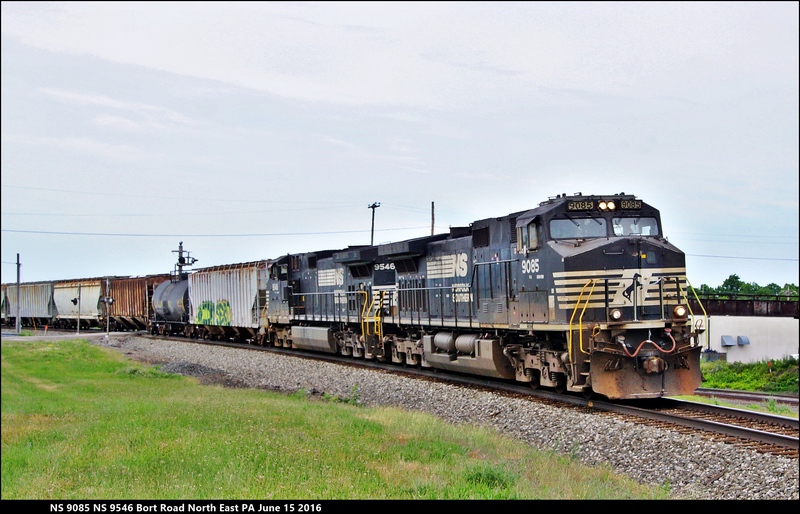
Thursday June 16th
Another catch of the Lakeshore Limited as it zoomed though ERie PA.

New day, new power on the test track as I caught NS 8166 and NS 8168, new Tier 4 locomotives on the test track.

NS 9318 NS 9978 come out of the morning Sun and roll through Erie. PA.
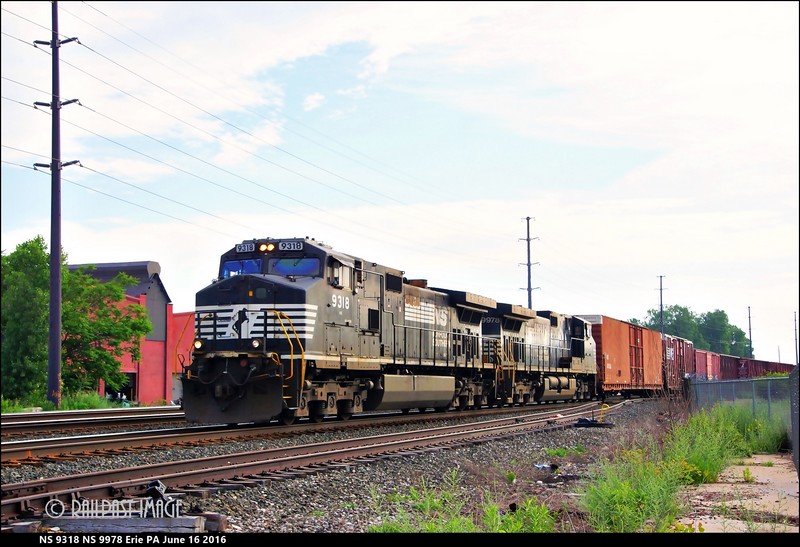
Off to North East PA and caught NS 9082 and NS 8147. I caught the same pair later as they were lifting the 4 FERROMEX units in Erie Pa.

Caught this CSX garbage train rolling through North East while I was there. Glad it never stopped.
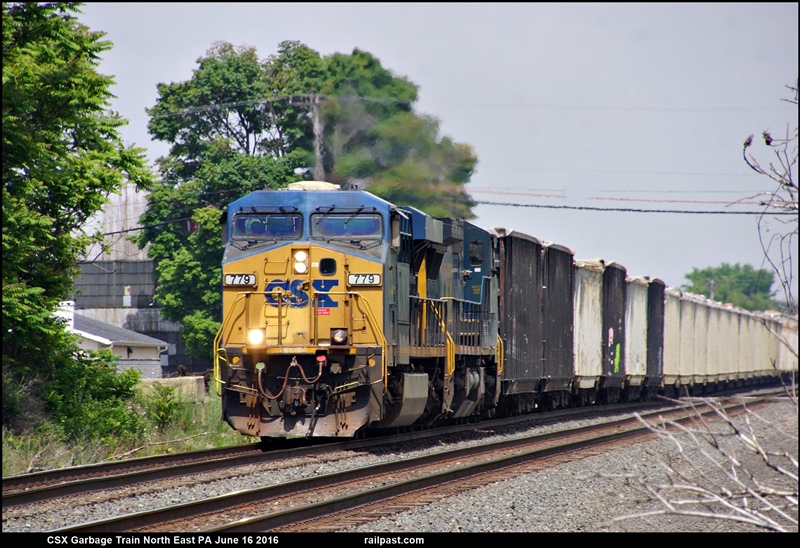
Back to Erie in time to catch NS leaving with the 4 FERROMEX units as they disappeared into the evening Sun.
Friday June 17th
Last day before heading home so back to Franklin Road in Erie to catch AMTRAK one last time.

Then heading home stopped at the Railpark at Westfield NY and caught a couple CSX train. CSX lead a trio past the signals at mile 58.

Then CSX 3139 bright and shiny leads a pair of units east.

Last catch was at Portland New York at Onthank Road as CSX 5264 leads a eastbound oil train.


I hope you enjoyed this photo report of my trip. I will be heading to Ohio in July so should have some new photos from Fostoria and Bellevue. See you trackside. Be safe out There.
Thanks for Looking. The CRO Web Guy
Norfolk Southern Stored Motive Power:
More than one hundred locomotives are still sitting in the rail yard between the Virginia Museum of Transportation, and the Norfolk Southern shop at Shaffer's Crossing. The railroad says most of the engines have been sidelined because of current business levels. This has affected not only NS ,but all the Class one railroads in the USA (and Canada). An NS spokesman said Roanoke has the space to store the equipment and two excellent locomotive shops for maintenance and repairs.
VIDEO http://tinyurl.com/jk8k7xp
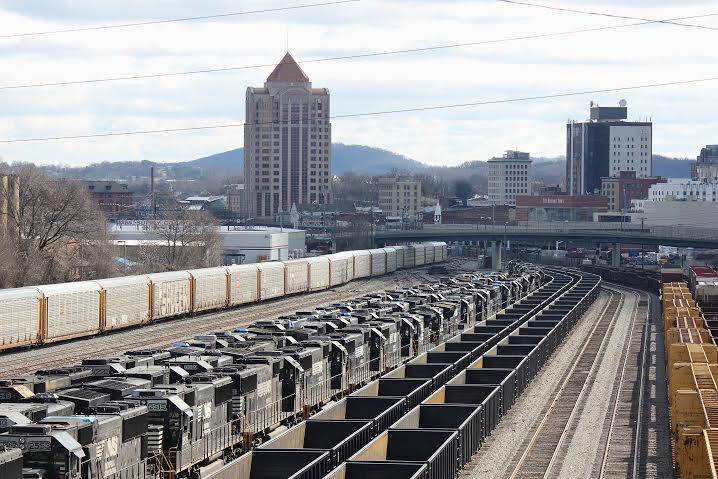
Great Smoky Mountains Railway GSMR 2-8-0 #1702
They're expecting to run this steam locomotive in a photo charter on August 20th from Dillsboro, NC... likely to Bryson City, including a shop tour on the layover! https://www.youtube.com/watch?v=eKoSoee6NDk
A curious onlooker inspects the #1702 during a brief layover at the Nantahala Outdoor Center in Wesser, North Carolina, USA on May 23rd, 2004. (Photo by John Higginson).

Summerville Steam Special "Doubleheader"
On June 4th, 2016 the Summerville Steam Special "Doubleheader" operated with Southern 630 and 4501. Tennessee Valley Railway Museum Summerville Steam Special from Chattanooga to Summerville Ga. This excursion was a "Doubleheader" featuring Southern Railway locomotives #630 and #4501. The Video begins in Rock Spring GA, and chases the train to Summerville where the locomotives were put on the turntable and faced the opposite direction for the northbound return to Chattanooga, Tennessee. Amateur rail fan and amateur photographer. This entire video was captured here:
VIDEO: https://www.youtube.com/watch?v=P27Gfin0G6M&feature=youtu.be

FERROMEX News
On June 15th, 2016, Walter Pfefferle shot brand new GE-built ES44AC locomotives in Erie PA, waiting for delivery to Norfolk Southern for forwarding to Ferromex in Mexico.

On Thursday he was lucky to hear a westbound NS train mention they had to lift 4 units at GE so he headed there and was lucky enough to catch them as they were lifted from the ready track. A good look as each unit rolled by.
|
Freshly painted FERROMEX SD40-2 3123 sports a test paint scheme for their yard power. You will see on the cab "Patio" which means "yard" in Spanish. |
 |
Southern SD40 3170
The Tennessee Valley Railroad Museum is pleased to announce the recent donation by Norfolk Southern of former Southern Railway diesel locomotive 3170, a model SD40. Built by the Electro-Motive Division
of General Motors in April 1971, 3170 was the first of 159 SD40 and SD40-2 units eventually rostered by the Southern, and she served for nearly forty years before being retired. Recognizing 3170's historical significance, Norfolk Southern, successor to Southern Railway, set aside the unit for preservation, while most sister locomotives were either converted to other uses or scrapped.
In 2015, NS returned the 3170 to service and repainted it in its original Southern Railway "Tuxedo" (black, light gray and gold) paint scheme. 3170 has spent the past year as the diesel escort for 21st Century Steam excursions and on display in special appearances across the NS system, as well as in regular freight service. SD40 locomotives were the most popular freight haulers of their era. They replaced the so-called "first generation" diesel locomotives that themselves displaced steam locomotives in the 1940s and 1950s. 3170 is believed to be one of only four SD40 locomotives preserved, out of approximately 1,268 built. Each is powered by a 3,000 horsepower 645-series General Motors engine.
For TVRM, Southern 3170 has additional significance: it joins Southern Railway steam locomotive 4501 in TVRM's collection, which was built in 1911. 4501 is a "Mikado"-type locomotive built for everyday freight-hauling service and can be considered the SD40 of its day. 4501 was the very first of 435 Mikado-type locomotives eventually owned by Southern. Like 4501, Southern 3170 will help to fulfill TVRM's mission of preserving, interpreting, displaying and operating trains in an authentic setting.
A formal dedication of the locomotive will be scheduled in the future. Log on to www.tvrail.com for more information.

Two Man Crews:
The Association of American Railroads (AAR) released on June 15 its comments filed with the Federal Railroad Administration (FRA) to withdraw its proposed rule mandating two-person crews on railroads. The AAR said that the proposal not only lacks any data-driven justification but could also undermine efforts to improve freight rail safety. "There is no greater priority for the freight rail industry than safety, but this proposed rule offers no safety benefit to railroads, their employees or the public," said Edward R. Hamberger, President and CEO of the AAR. "There is absolutely no data to support the view that a second crewmember enhances safety. This regulation is trying to solve a problem that does not exist." In its Notice of Proposed Rulemaking (NPRM) published on March 15, the FRA acknowledged that it lacks any data to support the assertion that two-person crews are safer than one-person crews. The FRA notes that "it is possible that one-person crews have contributed to the improving safety record" of the rail industry. AAR also states that the NPRM also largely ignored studies provided by AAR in January 2015 that quantify the strong safety record of single-person operations, which are used all over the world. "With no evidence that one-person operations are less safe, there is simply no basis for enacting a general prohibition on crew size reductions," Hamberger said. Historically, the FRA has treated crew size as a labor issue to be addressed through the collective bargaining process rather than as a safety issue. AAR believes by mandating crew sizes, the FRA would be creating a new economic burden for rail operators that already operate with only one crewmember, as well as those that would be prevented from reducing crew sizes in the future. AAR states that "the FRA's move is ironic because it comes just as the Class I railroads are in the process of implementing Positive Train Control (PTC) technology, which is designed to override human error in the cab." The AAR also emphasized that unnecessary rules like this may stifle future technological innovations that could make the freight rail network safer and more efficient. AAR states that new safety technologies often also provide productivity and efficiency gains to the railroads that implement them, and smart regulatory policy should be designed to encourage - not inhibit - railroads from investing in those technologies. This proposed rule is a textbook example of unnecessary regulation, and, if implemented, would have a chilling effect on the development of new technologies that could make the world's safest transportation network even safer," Hamberger said. "While the Department of Transportation is throwing its full support behind the development of autonomous vehicles as a way to improve safety on our roadways, it is doing the opposite with our railroads." (RAILWAY AGE)

Citing the Federal Railroad Administration's (FRA) acknowledgement of "little evidence or safety data" in its attempt to mandate two-person train crews, a proposed rule first announced by the FRA in April 2015, Association of American Railroads President and CEO Edward R. Hamberger said, "Safety is this industry's number one concern, but there is simply no safety case to be made for a regulation that requires two-person crews, especially where Positive Train Control is fully operational." "Worldwide, trains safely operate with one person in the cab, including here in the United States with passenger and commuter trains and some short line freight railroads. Major European railway systems running many mixed freight and passenger trains per day have safely implemented single-person train crews," Hamberger added. "Coming from an administration that champions smart, data-driven regulations, it is inexplicable how this proposal was approved by the President's Office of Management and Budget," Hamberger said. "Even the FRA concedes they have no 'reliable or conclusive statistical data' to suggest that two-person crews are safer. I encourage the FRA to reexamine the facts and exercise sound regulatory judgment before finalizing a rule that lacks empirical support." Hamberger pointed out Class I freight railroads remain committed to two people in the cab for trains operating on main line track that is not equipped with Positive Train Control (PTC). PTC will be in operation for 60,000 out of the nation's 140,000-mile freight rail system. "Notwithstanding an extensive body of evidence showing that two-person crews are no safer than one-person crews, the nation's Class I freight railroads currently operate with two-person crews, and have committed to continuing that practice for trains without PTC systems in place," Hamberger stated. "PTC is designed to provide continuous monitoring of train operations to protect against human error in controlling train speeds and movements. This is exactly the kind of safety redundancy through technology for which the FRA has long advocated. Hamberger also noted with irony that the proposed rule "comes from the Department of Transportation (DOT) at the same time as that agency is enthusiastically promoting autonomous vehicle technology, which would facilitate platoons of unmanned* trucks on our nation's highways. The same DOT is determining concrete guidelines for driverless* cars, but offers absolutely no guidance to the railroads to move to one person crews." "The freight rail industry is spending billions to automate operations inside freight locomotives. Instead of piling on additional, duplicative regulatory costs that offer no incremental safety benefit, the government should focus on creating an environment that fuels innovation and technological advancement in furtherance of safety," concluded Hamberger. Additionally, at a hearing on June 2, 2015, National Transportation Safety Board (NTSB) Chairman Christopher A. Hart stated that the board hadn't found two-person crews to be an improvement over singleperson crews. * Editor's note: Autonomous trucks are not "unmanned." The truck operates automatically on highways equippped with a control/guidance system, much like ATO (Automatic Train Operation) on a rapid transit system. There is a single "driver" in the tractor cab whose function is to monitor the truck's operation, and drive it manually off-highway (once the vehicle leaves the automatic zone). The same applies to "driverless" automobiles, which would operate automatically on highways equipped with the technology. This technology, as envisioned by the DOT, would be deployed only on the Interstate Highway system. AAR is correct, however, in pointing out that an agency that embraces autonomous vehicles is attempting to mandate two-person train crews when there is no safety case supporting this where PTC is displayed (RAILWAY AGE).
FOR THE GOLF & RAILROAD FANS!
On June 13th, 2016 in Oakmont, PA, David Kelsch shot the Iowa Interstate (OCS) Executive Business Train on the Allegheny Valley Railroad in Oakmont, PA. The Oakmont Country Club was hosting the PGA Golf Championship this year, and typically either the NS or Pittsburgh Native Henry Posner III, CEO of Iowa Interstate and a former Conrail veteran, always send a passenger train set. This Open's train set is IAIS GP38-2 #716, 711 and IAIS passenger car Abraham Lincoln and IAIS observation car Hawkeye.


Would you like to see your photos here?
Send us your USA Vignette photos.
AMTRAK VIGNETTES:
It's the summer of 1995 and we find Amtrak's International heading east for Toronto from Chicago led by VIA F40PH-2 6449. It's passing beneath the old NYC coal tower which stands to this day in Michigan City, IN on the former Conrail nee-Michigan Central. This line is owned by Amtrak, acquiring it at the beginning of Conrail in 1976 and is now part of a higher speed conversion to 110 mph in some locations. (Joseph "Tuch" Santucci Photo)

CONRAIL VIGNETTES:
In November of 1997, Bob Palmer shot a pair of C32-8 Ballast Express units work westbound through Wyomissing Jct with a loaded and very heavy ballast train from the nearby quarry at Dyers. The units which were specially painted grey for this Conrail M-O-W service, were really working hard in the photo and the sound was very memorable Bob says!

A profile view of GE Erie, PA built C32-8 (Conrail 6614) in service when still brand new in the late-1980's! (Bob Gottschall photo).
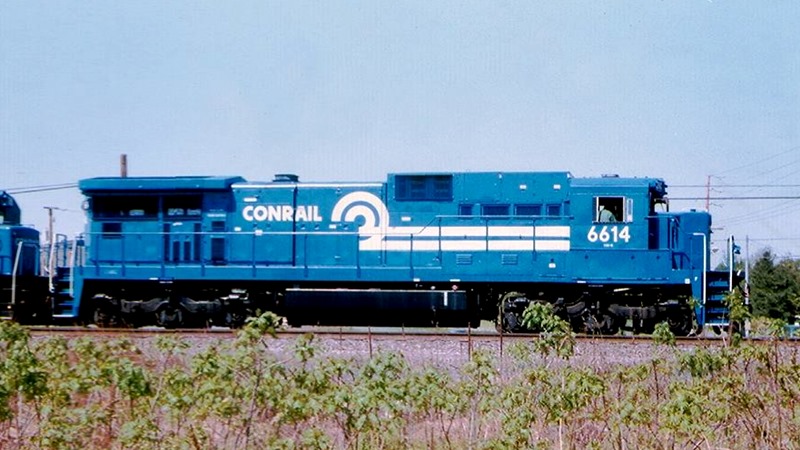
|
On February 7th, 1987, two-year old Conrail C36-7 6643 sits at the Frontier Yard diesel facility in Buffalo, NY between assignments. This locomotive was built at GE Erie, PA back in June 1985. In those days, Bill Grandin, my Dad, and I used to simply drive right in the yard, and up right next to the units at the facility, and shoot from the car with no problems! Them's was the days friends! |
|
|
On February 7th, 1987, New Conrail C36-7 6624 has a little "chin wag" with an old school GP30 (CR 2231) outside the Frontier Yard Diesel Shop in Buffalo, NY. |
|
UNION PACIFIC VIGNETTES:
|
UP SD40-2 3322 was shot in Ft. Worth TX on February 25th, 1988. She was built at EMD LaGrange #767021-18 in July 1976. The Union Pacific's "WE CAN HANDLE IT" slogan was still in fashion in those years! (Robert Carter Photo) |
 |
Dennis Webber submitted his shot of CNW 4153 taken at Altoona, Wisconsin in April 1995.
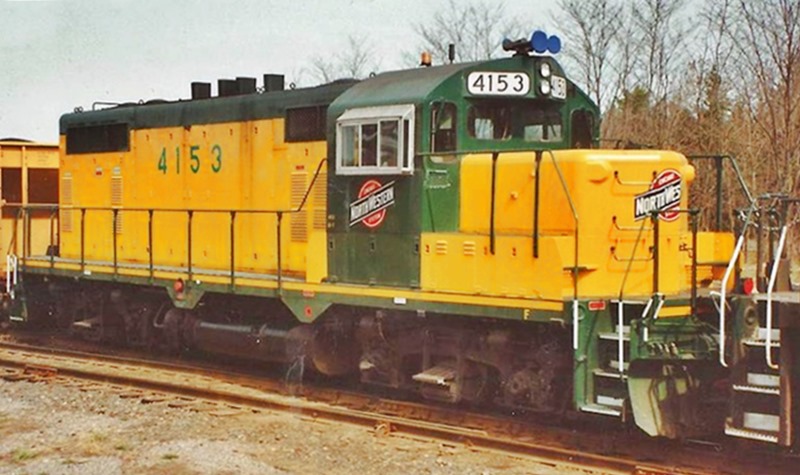
|
On May 20th, 1987, EMD-built SD60 UP 6003 looks lovely sitting at North Platt, Nebraska. |
|
|
EMD-built SD60 (Union Pacific 6071), sits in the sun at the former MoPac, (nee-C&EI) Diesel Facility in Dolton, IL on April 16th, 1986. Bill Grandin photo Collection). |
|
|
GE-built C40-8 9135 looks great at Salt Lake City, Utah on July 30th, 1088. At this time, no one would believe that CN would many years later purchase a group of ex-UP / ex- CNW C40-8's! |
|
|
Brand new from GE Erie PA, UP C40-8 9235 and three siblings are being delivered to UP on Conrail at their yard in Cleveland, Ohio in 1988. |
|
Click HERE to Submit Photos to South of the Border
Copyright CRO July 2016




